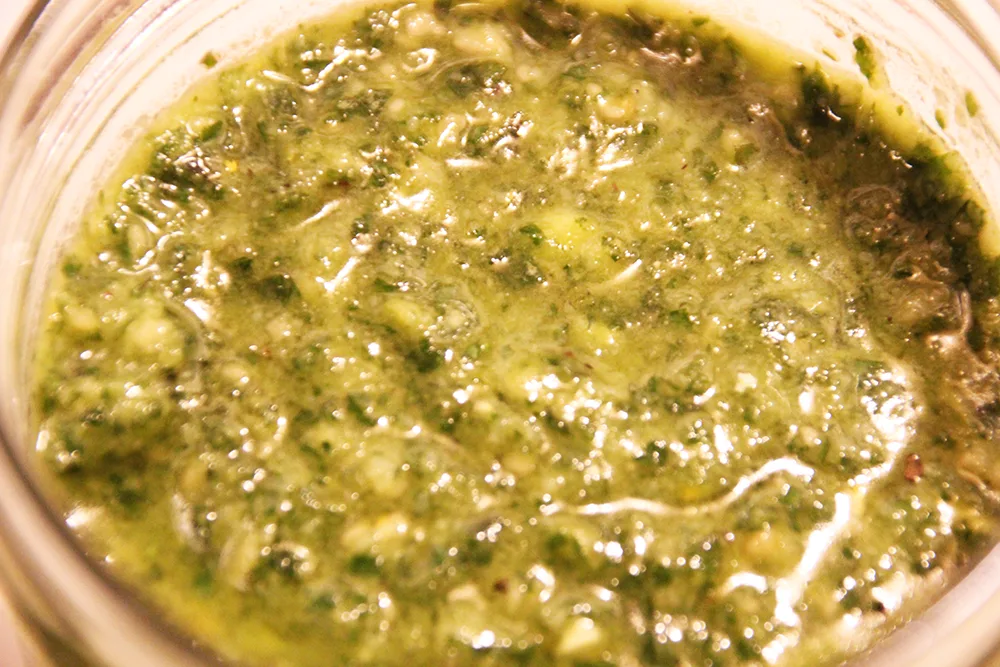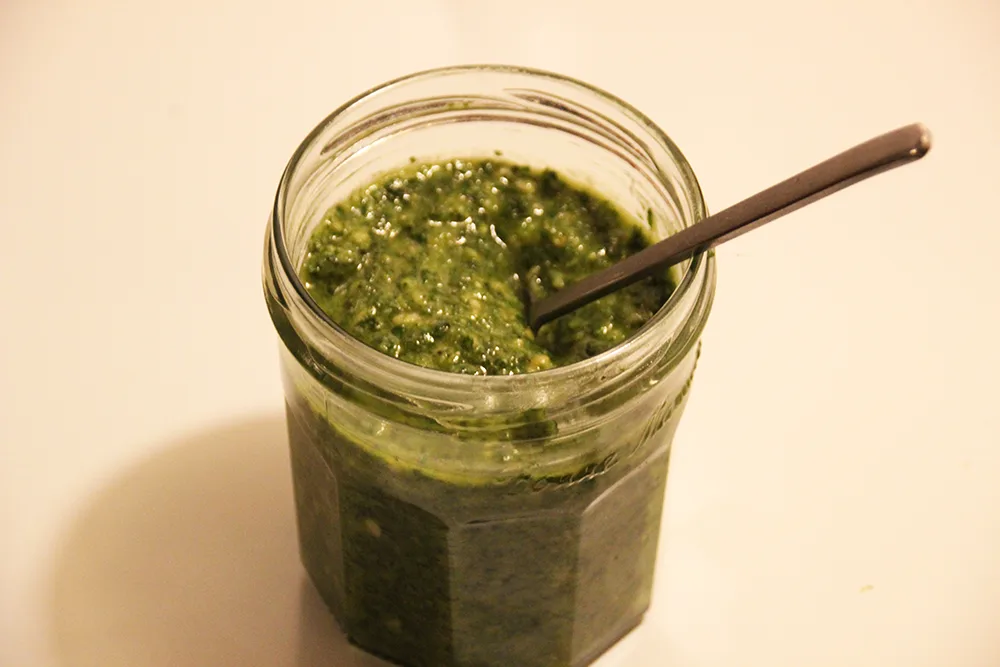The History of Pesto Genovese
By Ian MacAllen on Friday, September 20th, 2024 at 3:20 am | 5,543 views

Spicy, creamy, and bright green, Pesto Genovese has become synonymous with modern Italian cuisine, particularly in the United States. But that wasn’t always the case, and even in Italy it was hard to find outside of Liguria until just a few decades ago. So how did this quintessential sauce conquer the world?
Pesto Genovese is a pungent paste made with basil, pine nuts, garlic, parmigiana cheese, and oil. Today it’s common on hot pasta dishes, cold pasta salads, as a condiment on sandwiches, caprese salads, pizza, and even as a dipping sauce for appetizers and finger foods, not unlike its origins in medieval cooking.
If the name Pesto Genovese doesn’t give it away, pesto comes from the city of Genoa, the capital of Liguria. Liguria is the coastal region in northern Italy extending from the French border to Tuscany. For close to a millennia, the independent Republic of Genoa long controlled the seas with a powerful navy and merchant marine. By extension, it also participated in, or controlled trade on the seas for centuries. The sea influenced the region’s culinary heritage mainly in two ways: the people ate lots of seafood and needed foods that do not spoil easily. Pesto, and early variations, serve both needs as a condiment for fish and with a long shelf life.
There are as many variations of pesto in Liguria as there are kitchens. Dorothy Rankin’s 1985 recipe book, Pestos! includes recipes for pesto sauces made in many different combinations, including red basil, oregano, sorrel, watercress, mint, and other leafy greens. But the recipe made with basil, cheese, and pine nuts, today thought of as traditional, is only about 140 years old, and only in the last 60 years has it come to be the dominant version.
The term pesto itself refers to the act of crushing the ingredients. The verb, pestare, means to beat or crush and describes the act of making it. A true pesto cannot be made with a knife as no cook can chop the ingredients finely enough, and only in recent years have mechanical food processors relieved cooks of the need for a mortar and pestle.
There are likely some very early condiments similar to pesto dating back to ancient Rome, but it is in the Renaissance era where a clear connection to the modern recipe can be seen. Agliata, a condiment made from crushed garlic originated in Rome and survived in Ligurian cooking. Early recipes for agliata included mixing garlic, almonds, and broth, according to Luca Cesari, in The Discovery Of Pasta. These recipes often included other items like bread crumbs or vinegar, creating sauces to top fish and meat or was served alone. Agliata was common in Ligurian foods for centuries.
As early as the 1500s, agliata made with arugula and mixed greens, herbs, and cheese began to appear in Liguria, laying the groundwork for what eventually became pesto. For much of history, spices were added to meat or fish to disguise the flavor of rotten flesh, and all too common occurrence before refrigeration.
By the 19th century, the modern style of pesto first emerged as a product distinct from agliata. The earliest of these appear in cookbooks in the mid-century. Cesari notes that in 1841, the Codice gastrologico economico included a recipe for a fast day lasagna made with basil, Roman cheese, and garlic crushed together. Fast days were part of the Catholic traditions that barred eating meat and sometimes other foods like butter. A lasagna made with pesto would offer a flavorful, meatless dish that satisfied the requirements.
Similarly, the 1852 book Vera Cuciniera Genovese, by Emanuele Rossi, includes the Pesto d’aglio e basilico calls for garlic, oil, a mix of Dutch cheese and Parmigiana, ground into a paste and suggests serving on gnocchi, taglierini, or lasagna.
These two early recipes notably lack pine nuts, considered today as part of the traditional recipe. According to Cesari, the first recipe with pine nuts appeared in 1880 in the Cucina di strettissimo magro, but even up through the 1960s, they were not viewed as essential to pesto.
Pesto was also not necessarily a pasta sauce then either. It was often used to flavor minestrone soup with a dollop added at serving. Cooking the pesto would ruin the freshness of the herbs, but added when served enhanced the flavor. Another common dish is made by combining pesto, pasta, boiled potatoes, and green beans to make something resembling a potato salad. Genovese cooks were also more likely to serve it on gnocchi made either with potatoes or spinach rather than wheat pasta – ironic since by the 19th century, Genoa had grown into a hub of dried macaroni manufacturing.
The widespread use of pesto is a relatively recent phenomenon. Waverly Root writing in the 1971 book, The Food of Italy, describes pesto as “unfindable” elsewhere. This is not entirely true in that pesto had already appeared in the United States, but he likely means within Italy, pesto genovese remained very much associated with and limited to Genoa and Liguria. Root does mention that basil pesto is similar to French pistou found along the riviera. Pistou, he notes, it is much milder. Pistou may have a closer relationship to the early 19th century pesto sauces since it lacks cheese as an ingredient.

The arrival of pesto in the United States had little to do with the mass migration of southern Italians in the 1880s. No doubt there are some rare examples of pesto entering into Italian American foods in the early decades of the 20th century. For instance, an Italian-language newspaper in San Francisco does mention Lasange with Pesto alla genovese as early as 1909. But generally this is the exception. Southern Italians were likely unaware or uncustomed to Pesto Genovese when they first immigrated to the United States, and the sauce does not have a long history in traditional red sauce joints.
Instead, pesto is introduced as a kind of foreign food, not by Italians, but by food enthusiasts. One of the earliest instances of pesto in America comes from George Rector. Rector and his father had been famous restaurateurs around the turn of the 20th century. But George exited the restaurant business (in part because of Prohibition) to become a food writer and columnist. He wrote for venues like the Saturday Evening Post cashing in on his name, then well known for the family restaurants. He also wrote The Rector Cook Book in 1928, based on his columns. One of the many dishes he popularized includes fettuccine Alfredo.
And in the 1930s, he helped publicize Minestrone a La Genovese, a soup topped with pesto sauce. He actually did live presentations teaching audiences how to make the soup, pesto, and alfredo noodles. His pesto recipe included butter, parsley, cream – but no basil. The same recipe showed up in Better Homes and Gardens in 1936.
The New York Times in 1944 included a brief blurb from Jane Holt about an Italian Spaghetti Paste. She wrote that it is “relatively little known,” and describes it as having chopped parsley, anise, basil, garlic, cheese, and olive oil. Holt references a tin, suggesting she’s buying a premade pesto sauce rather than making her own. She follows up in 1945 with an article highlighting Manganaro’s Delicatessen on 9th Avenue, and cites pesto as a sauce that can be bought from the shop for hosting an Italian dinner night.
Jarred pesto is largely how Americans were introduced to the sauce. A New York Times article from 1955 notes that pesto can be bought at Bloomingdale’s of all places. It was still then an exotic luxury. That began to change as the decade progressed.
Craig Claiborne, the famed New York Times food writer, introduced a pesto recipe in 1959. His recipe still does not include pine nuts or walnuts, but he does signal a monumental shift in pesto recipes – he calls for an electric blender. Tabletop appliances became important hallmarks of modern kitchen equipment, and devices like blenders and food processors, in some cases, were solutions looking for problems. In the case of pesto, it eliminated the need to crush the paste.
Jean Anderson, in the 1997 American Century Cookbook, notes that “the food processor has revolutionized the making of pesto.” Not to say American cooks are lazy, but there’s few conveniences they don’t love when it comes to food preparation. By the 1970s, pesto started becoming better known among American consumers, and the ease of making it probably helped that transition.
The 1970s also saw other changes in Italian food. A variety of cultural influences at the time saw red sauce joints begin to close down. The public had come to favor “northern” or “authentic” Italian cuisine. Pesto became a signifier of the new style of food. Northern, lighter, “healthier,” pesto became the green alternative to red sauce.
Another aspect of the rise of pesto was that manufacturers of jarred, canned, and even frozen pesto also helped educate Americans on the uses. They created recipes to help sell prepared pesto products, like an early spiral lasagna recipe, Parmesan Pesto Flan, Tuna Pesto, and Pesto Pasta Salad.
Pesto had caught the nation’s culinary imagination. The advertorial recipes helped make pesto a trendy new ingredient, and ignited numerous trends we take for granted today. In the mid-1980s, pesto became a common pizza sauce, replacing traditional tomato sauce. Pesto and chicken also came together in the 1980s for salads and tossed together with pasta. And by the 2000s, pesto had become a common sandwich condiment. A 2003 Kathy comic strip even has the eponymous character bemoaning turkey pesto sandwiches.
Today, pesto sauce is available from dozens of brands. It’s sold in jars, cans, frozen, refrigerated, or even as a seasoning packet. There are imported brands and domestic, and available in just about every price point. These pre-made sauce lines also include other ingredients like tomato pesto sauce, roasted garlic pesto, and artichoke pesto.
In Italy, Pesto is a more serious matter. Pesto alla Genovese is a now protected term by the agricultural minister, earning a spot on the list of products of Liguria, the Prodotti agroalimentari tradizionali (P.A.T.). The Consorzio del Pesto Genovese, the consortium of Pesto Genovese also has an official recipe that unsurprisingly calls for basil grown in Liguria, as well as PDO protected Parmigiano Reggiano, Granada Padano, or Pecorino.
Pesto is so sacred, Genoa’s airport security will even allow up to 500g of pesto to pass through airport security despite its quasi-liquid state. (Perhaps don’t plan on a destination in the United States, where extra security is often required).
Since 2007, Roberto Panizza and the Palatifini Association, have hosted the World Championship of Pesto with Mortar in Genoa. The March 2024 championship included contestants ranging in age from 23 to 90, with the winner Mattia Batti hailing from Liguria.
Pesto has become a powerful symbol of Italian cuisine today. Its widespread consumption in the United States illustrates how much has changed for people of Italian ancestry. A century ago, a common slur was to call Italian immigrants garlic eaters. Today, just about everyone has eaten garlic-laced pesto.
Recipes:
George Rector’s Pesto (1935)
(to add to Minestrone soup)
Ingredients
3 tablespoons butter
3 tablespoons olive oil
3 tablespoons grated cheese
¼ cup cream
2 tablespoons parsley
1 clove garlic
Instructions
Cream butter
Stir in ingredients one at a time
Add to soup
Bring to boil
Craig Claiborne’s Pesto (1959)
Ingredients
6 cloves of garlic
2 cups basil
¼ cup olive oil
½ cup parmigiana cheese or romano
Salt
Instructions
Add garlic to electric blender
Blend in basil and oil
Mince finely with blender
Add cheese and blend
Add additional oil if necessary


